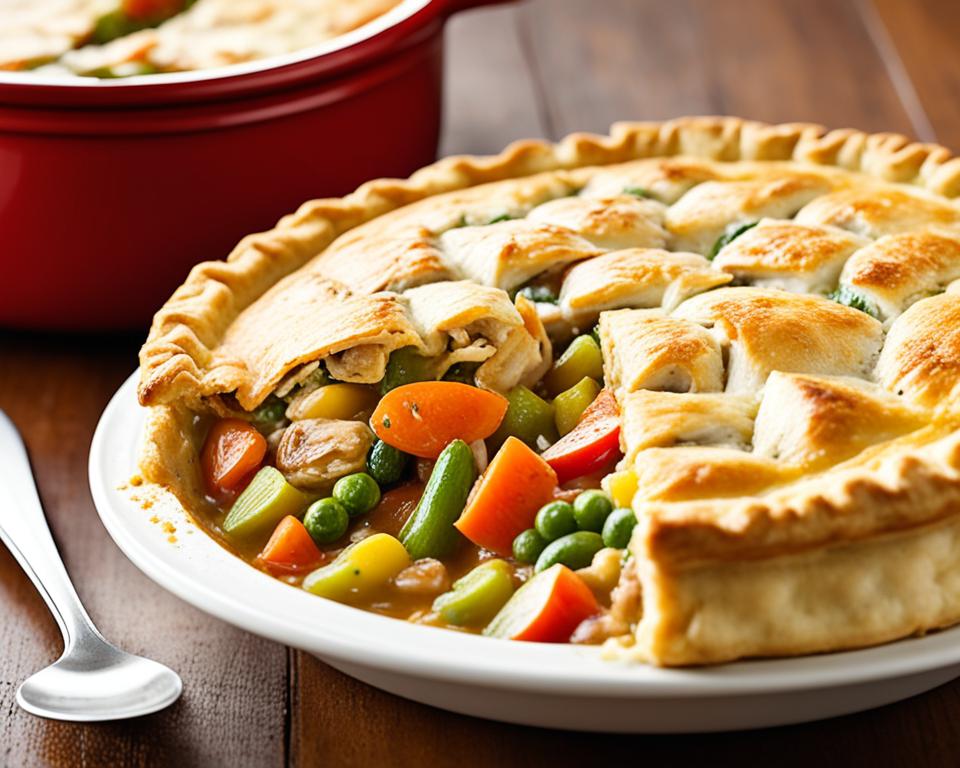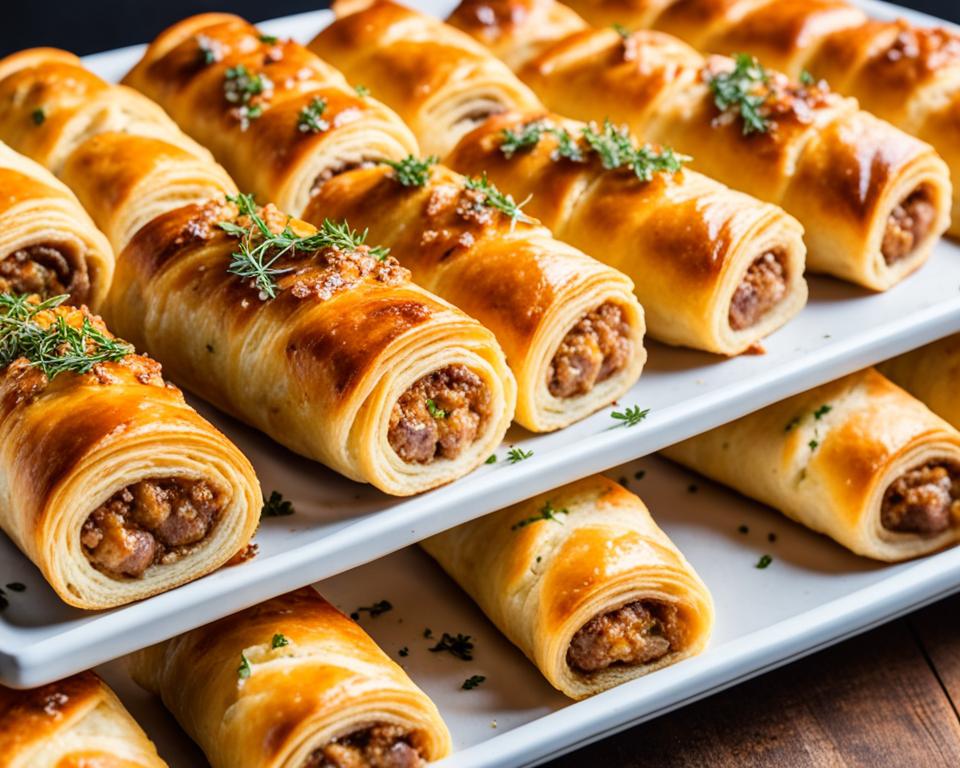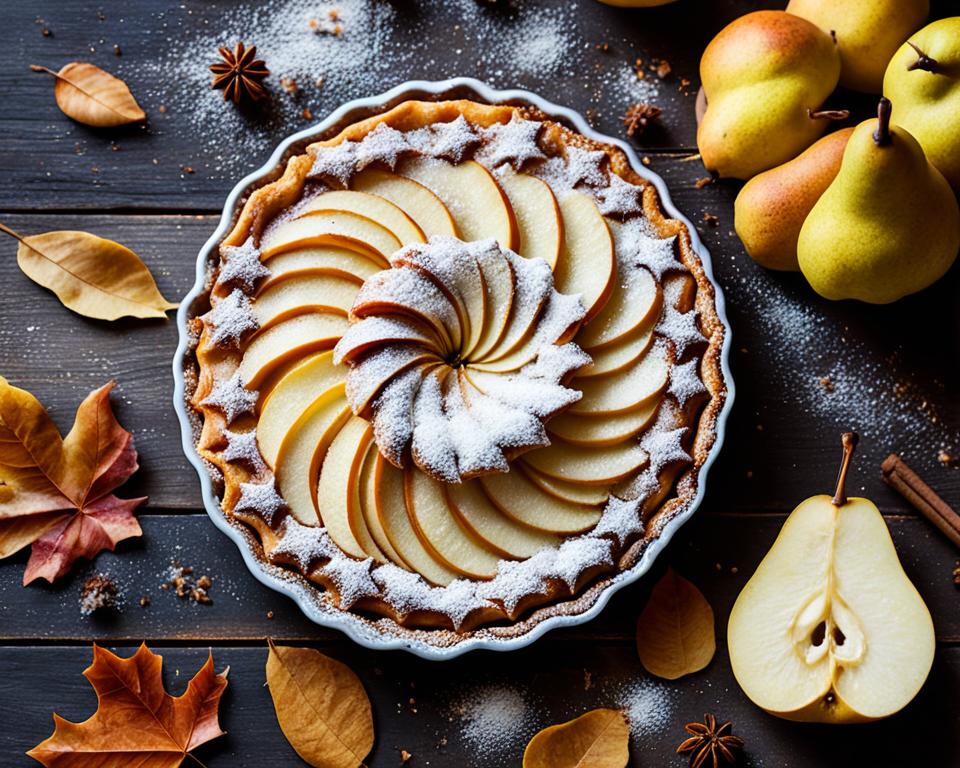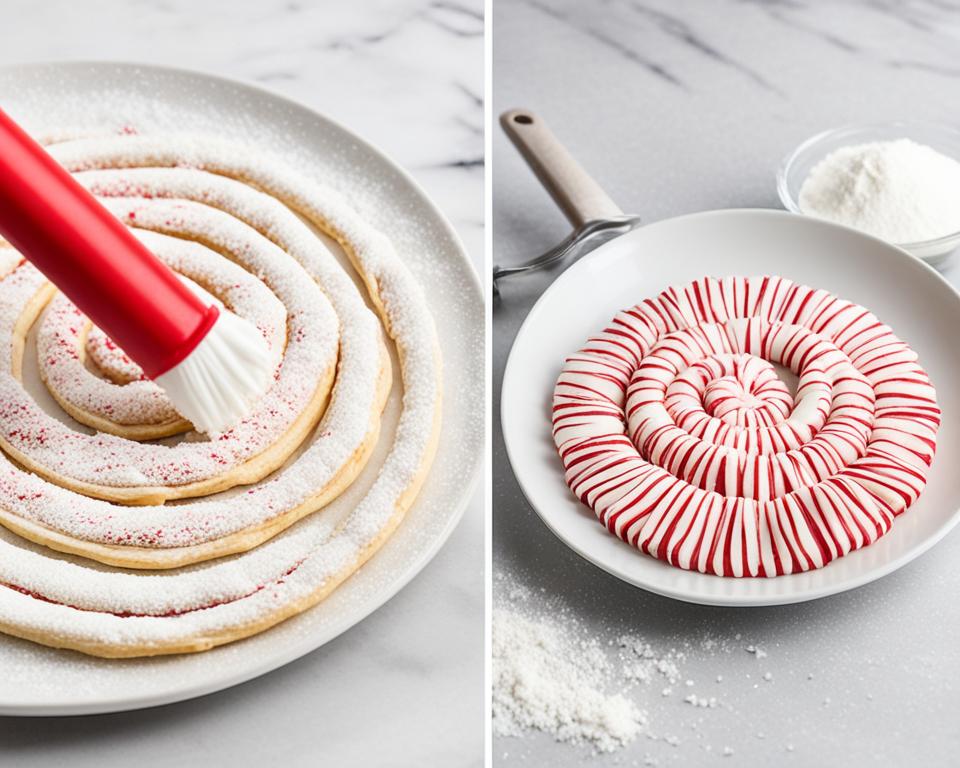Nothing quite encapsulates the essence of a classic comfort dish like a homemade flaky chicken pot pie. This savory pie dish is the epitome of heartwarming American cuisine, combining a golden-brown, buttery flaky crust with a rich, hearty filling. More than just a meal, it symbolizes love in every bite, representing home-cooked tradition and culinary care.
Whether for a festive gathering or a simple family dinner, the homemade pot pie recipe stands out as a cherished favorite. Its golden crust, enveloping a steaming savory center, is a testament to the joy of cooking from scratch. The divine layers of flavor in this flaky chicken pot pie have the power to transport you to a place of comfort and satisfaction.
Embracing the age-old traditions and unparalleled taste, we dive into the alchemy behind mastering the perfect pot pie. With each ingredient handpicked for quality and flavor, constructing this beloved dish is nothing short of an art. Join us as we explore the homemade flaky chicken pot pie, an emblem of comfort food done right.
Key Takeaways
- A flaky chicken pot pie is not just a dish but an embodiment of comfort and culinary tradition.
- Creating a homemade pot pie recipe allows for a personalized touch to this classic comfort dish.
- The golden, buttery, and flaky crust is essential to the iconic taste and texture of the savory pie dish.
- Investing time into crafting a pot pie from scratch results in layers of rich and heartwarming flavors.
- The perfect pot pie is a labor of love, bringing families and friends together over a shared appreciation for timeless American cuisine.
Savoring the Comfort of Homemade Pot Pie
When the air turns crisp and the leaves start to fall, our culinary cravings turn to the kind of comfort food that nurtures both body and soul. Just one dish stands out in its ability to envelop us in warmth and a flood of cozy memories: the classic, hearty chicken pot pie. This sumptuous feast is not merely a meal but a blanket of solace, with its delicious pot pie filling cradled in a flaky crust that has weathered generations of family dinners and joyous occasions.
For many, the mere thought of a homemade pot pie stirs the pangs of nostalgia, evoking images of steaming kitchens and laughter-rimmed tables. A dish that transcends time, the pot pie’s crust golden and crisp is an emblem of American cuisine, served up with stories as tender as the chicken ensconced within.
The Role of Comfort Food in American Cuisine
In the pantheon of American comfort food, the homemade chicken pot pie reigns supreme. It isn’t just sustenance; it’s a vessel of tradition, carrying flavors refined through the ages. From humble beginnings to ornate holiday centerpieces, this comfort dish has been a bellwether of togetherness and contentment. Known for its hearty embrace, it is a quintessential experience, a hearty balm for the soul.
Why Homemade Pot Pie Outshines Store-Bought Varieties
The perfection of a homemade pot pie lies in its perennial appeal and the added value of personal touch. Unlike the store-bought varieties, homemade pot pies offer an unparalleled freshness and quality. Devoid of preservatives and filled with love, these pies boast crusts that melt in your mouth, and fillings that are rich, savory, and brimming with flavors – telling tales of their maker’s care and culinary intellect.
- Fresh ingredients ensure a filling that celebrates the nuanced symphony of its parts.
- Vibrant herbs and spices meld in a delicious harmony absent in commercial concoctions.
- The pleasure derived from crafting a pie from scratch is unmatched, from rolling the dough to simmering the filling.
- Personalization allows for a unique signature – a dish that carries your brand of comfort.
A homemade chicken pot pie is not just food; it’s the taste of home, of nurturing, and of a simple culinary joy that no pre-made pie could ever hope to match. Bringing together ingredients with a dose of creativity to form that perfect flaky vessel, filled to the brim with nutritious goodness, ensures the homemade variety remains the hot favorite.
Essential Ingredients for a Hearty Chicken Pot Pie
Creating the quintessential easy chicken pot pie begins with selecting high-quality ingredients that meld together to form the perfect medley of flavors. Every component counts, from the succulent chicken that forms the backbone of the dish, to the medley of vegetables that bring color, texture, and taste to the table.
Choosing the Best Chicken for Your Pot Pie
The secret to a moist and flavorful chicken pot pie filling lies in the chicken you choose. Opting for tender, juicy cuts of chicken will ensure each bite is perfectly satisfying. Slow-roasted or sous vide chicken breasts are top choices for their even cooking and ability to retain moisture, contributing to the overall tenderness of the dish.
The Vegetables that Elevate Flavor
In addition to well-prepared chicken, the right mix of vegetables can transform your easy chicken pot pie into an unforgettable meal. Onions, carrots, and celery form the classic base, providing a depth of flavor that is both rustically traditional and profoundly comforting. Peas add a touch of sweetness and a vibrant burst of color, complementing the creamy richness of the filling.
These vegetables not only enhance the flavor profile but also contribute vital nutrients, making the dish wholesome as well as delicious. Below is a detailed table of the vegetables typically used in a hearty chicken pot pie, showcasing the harmony between health and taste.
| Vegetable | Flavor Profile | Texture | Nutritional Value |
|---|---|---|---|
| Onion | Sweet and savory depth | Soft when cooked | High in vitamin C and antioxidants |
| Carrot | Slightly sweet, earthy | Firm, tender when cooked | Rich in beta-carotene and fiber |
| Celery | Mildly bitter, fresh | Crispy, becomes tender | Low in calories, high in vitamins A, C, and K |
| Peas | Sweet and starchy | Soft and slightly resilient | Packed with protein, vitamins, and fiber |
Assembling these ingredients with the best pot pie crust creates a symphony that dances across the palate, resonating with the inviting allure of homemade goodness. It’s this interplay of flavors and textures that makes a homemade chicken pot pie not just a meal, but an experience.
Creating the Perfect Flaky Pie Crust Recipe
Every home chef understands that the foundation of a memorable homemade chicken pot pie lies in the mastery of a flaky pie crust recipe. It’s the key that unlocks the doors to comfort food heaven, enveloping your rich, savory filling in a tender, buttery embrace. Successfully achieving that prized flakiness involves careful attention to detail and a gentle touch during the preparation process.
The cornerstone of perfection starts with very cold butter. Not just chilled, but almost to the point of freezing, as the temperature of the butter makes a definitive difference in the end product. By keeping the butter cold, you create small pockets that turn into delicate, airy layers as the pie bakes, resulting in the hallmark flakes that make each bite sublime.
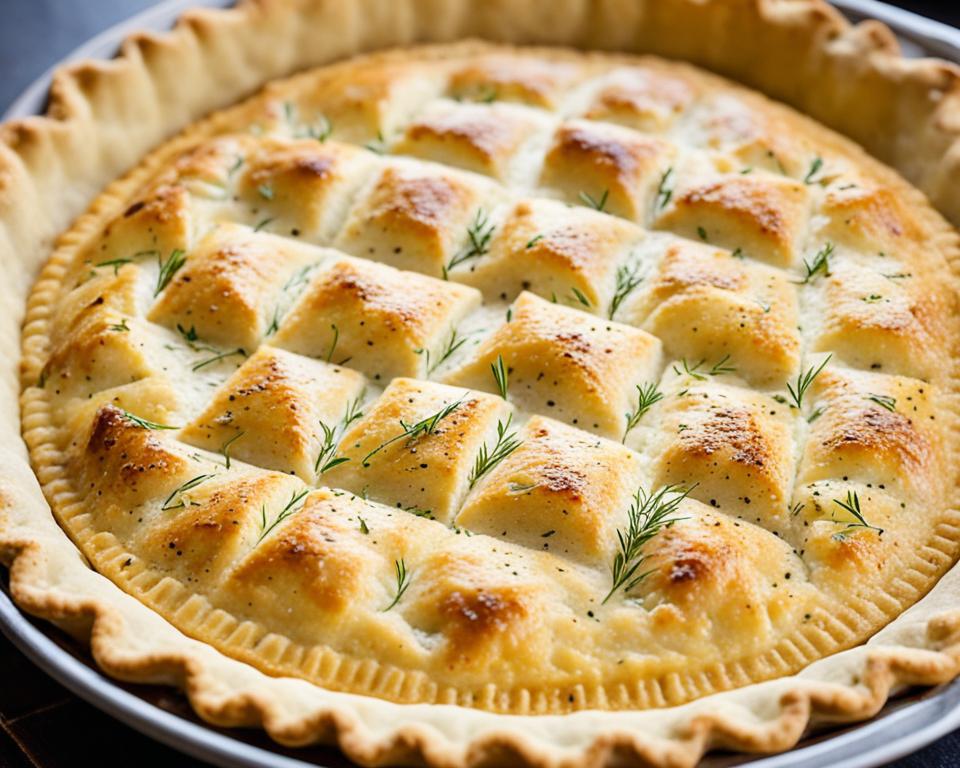
Another critical aspect is to avoid overworking the dough. The less you handle it, the less gluten develops, which translates to a crust that’s tender, not tough. Incorporating a touch of vinegar further inhibits gluten formation and is a tried-and-true secret that pastry chefs have sworn by for decades. It’s these subtleties in technique that transform a good pie crust into a great one.
To help eager bakers in their quest for flaky excellence, here’s a breakdown of the steps and essential tips:
- Start by pulsing together flour and salt in a food processor to ensure they’re well mixed.
- Cut your very cold butter into small, uniform cubes for easy incorporation. Scatter these cubes over the flour mixture and give it a few pulses until pea-sized pieces form.
- Add ice-cold water and vinegar in small increments, pulsing just until the mixture resembles a crumbly texture.
- Tip the crumbly dough onto a piece of plastic wrap and bring together with the wrap’s help to form a disk. Let the dough’s own moisture and the gentle pressure work their magic.
- Refrigerate the wrapped dough for at least one hour before rolling out. This rest period allows the dough to hydrate evenly and the butter to harden, setting the stage for the flakiness aficionados covet.
Remember, each pie crust is a blank canvas awaiting your creative touch. But to ascend to the peak of flaky pie crust mastery, one must follow these guiding principles with each loving roll of the pin. In the end, what emerges from the oven is more than just a component of a dish — it’s a testament to the art of baking and the warmth of home.
Navigating the Steps for an Easy Chicken Pot Pie
The quintessential homemade pot pie recipe represents the very essence of a classic comfort dish, tantalizing the senses with its rich aromas and delightful textures. Crafting an easy chicken pot pie at home not only satiates your hunger but also nourishes the soul with every forkful of its flaky, buttery goodness. Let’s walk through the crucial steps to create this staple of home-cooked excellence.
Prepping Vegetables for Maximum Flavor
One of the secrets to a recipe’s success lies in the preparation of its components, and for a pot pie, it starts with the vegetables. Tender, aromatic vegetables are the foundation of any classic chicken pot pie, and their preparation is straightforward yet pivotal. Sautéing onions, carrots, and celery in a touch of butter not only softens them but also unlocks their natural sugars and aromas, forming a base that is as fragrant as it is flavorful.
The humble potato, with its comforting starchy presence, rounds out the vegetable ensemble. After a brief immersion in boiling water, diced potatoes become perfectly tender, ready to meld with the rest of the filling. This process isn’t just about cooking the potatoes; it’s about ensuring they contribute a comforting bite to the overall texture of the dish.
Assembling Ingredients for Effective Cooking
The heart of a homemade chicken pot pie is its filling — a luscious amalgam of sautéed vegetables, tender potatoes, and succulent chicken bathed in a creamy, savory sauce. The stir-in of a rich mixture consisting of butter, flour, milk, and cornstarch transforms the sautéed base into a symphony of thickness and taste. What begins as separate ingredients soon becomes an indulgent pool of flavors, showcasing the harmony between each addition.
Once the vegetables have reached their peak tenderness, and the sauce has thickened to the ideal consistency, the cooked chicken — preferentially juicy and flavorful — is incorporated along with vibrant green peas. These steps form a delicious, creamy filling that stands as the soul of your pot pie, now ready to be encased within what many argue to be the best pot pie crust.
Ensuring your pot pie filling is enveloped by a crust that epitomizes flakiness is nothing short of an art. The dough, when rolled and laid out, anticipating the sumptuous filling it will soon contain, represents the final element that elevates a homemade pot pie recipe from merely good to undeniably great. From here, it only takes a preheated oven and an attentive eye to bake this comfort food classic to golden brown perfection. So gear up for a little kitchen adventure and get ready to enjoy a pot pie that truly tastes like home.
The Secret to a Buttery-Soft, Golden-Brown Crust
When it comes to preparing a chicken pot pie that epitomizes comfort and indulgence, the crust is paramount. Home cooks and chefs alike strive for that best pot pie crust—one that’s buttery-soft with a golden-brown hue, promising a symphony of textures with each bite. Securing this sensory delight centers on the manipulation of butter and dough, a process where technique is equally as crucial as the ingredients themselves.
The hallmark of a superb crust resides in the tiny steam pockets that puff up during baking. This flakiness, a sign of a well-executed pie crust, is achieved through the intentional use of very cold butter. The colder the butter, the less it integrates into the dough before baking—ensuring those pockets remain intact until the heat of the oven transforms them.
Yet another critical aspect is the gentle handling of the dough. Overworking the pastry not only develops gluten but also warms the butter, compromising its ability to facilitate flakiness. Therefore, minimal manipulation is the companion of coldness in the journey to crust perfection. Moreover, an egg yolk wash brushed over the surface prior to baking imbues the pastry with a tempting glossy, golden-brown finish. Merely the sight of such a crust is an invitation to savor the delicacy it encases.
The ideal pot pie crust can seem elusive, but the following presents a list of tips geared towards crafting that perfect pastry:
- Start with the butter at nearly frozen temperatures, cut into small, uniform cubes for ease of incorporation without excessive manipulation.
- Limit the time the dough is handled; it is the mixing—not the ingredients themselves—that contributes to the final texture.
- Use a pastry brush to coat the crust lightly with egg yolk before baking to achieve the golden-brown color that is both aesthetically pleasing and flavor-enhancing.
In summary, the science behind the best pot pie crust isn’t just rooted in the ingredients; the temperatures and techniques employed have a significant impact. With every carefully rolled out dough and precisely sliced pat of butter, each pot pie is a step closer to meeting the gold standard of a flaky, flavorful feast.
Mastering the Filling: Rich, Creamy, and Flavorful
Finding the perfect balance of ingredients to achieve the most delicious pot pie filling doesn’t have to be a culinary conundrum. The right blend of chicken broth and cream, partnered with a mix of flour and cornstarch, can elevate the simplicity of chicken pot pie to new heights, offering a rich, creamy, and flavorful experience.
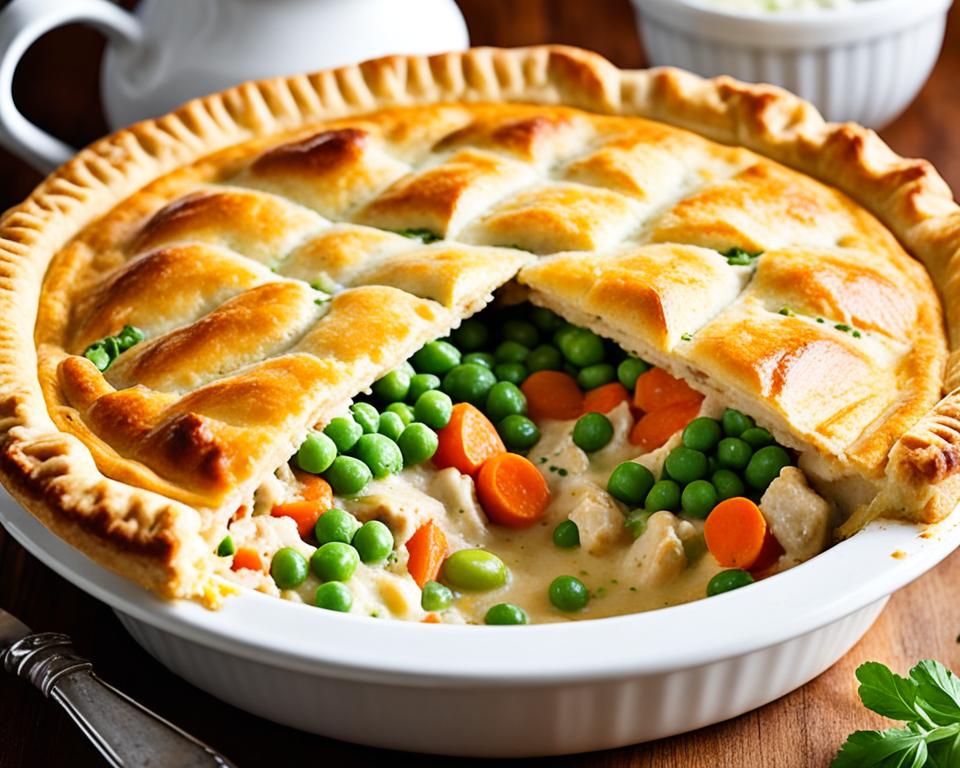
Perfecting the Balance of Chicken Broth and Cream
Creating a pot pie filling that’s both creamy and full-bodied involves a bit of know-how with chicken broth and cream. The broth offers depth and a savory backdrop, which, when melded with the luscious texture of cream, gives rise to a filling that’s both silky and rich. The trick is to combine these liquids in just the right proportion, ensuring the filling is sumptuous without being overwhelmingly dense.
How Flour and Cornstarch Work Together
To thicken the savory pool of chicken and vegetables within your pie, a duo of flour and cornstarch is employed. Each thickening agent brings its own set of properties to the dish. Flour, in its reliable heft, provides a heartier taste and a richer color. Cornstarch, on the other hand, offers a silkier, more delicate consistency. The joint operation of flour and cornstarch ensures the delicious pot pie filling achieves the coveted creamy thickness that scoops perfectly onto a fork without losing integrity.
| Ingredient | Thickening Power | Flavor Contribution | Texture Attribute |
|---|---|---|---|
| All-Purpose Flour | Reliable | Hearty, slightly nutty | Rich, opaque finish |
| Cornstarch | Powerful | Neutral | Smooth, translucent finish |
The intricate dance between these elements equals pot pie perfection— a bowl of comfort topped with a flaky crust hat. With these tips in your culinary toolkit, the pathway to a hearty and delicious pot pie filling is well within reach.
A Guide to Thickening Agents: Flour vs. Cornstarch in Pot Pie
When crafting the ultimate savory pie dish like a chicken pot pie, achieving the perfect consistency in the filling is paramount. The thickening agents you choose play a critical role in this process. Traditionally, flour and cornstarch have been the stalwarts for thickening, each bringing their distinct properties to the mixture. Understanding how best to use these agents can elevate your pot pie from good to sublime.
In the battle between flour and cornstarch, one must appreciate their respective merits. Flour is a classic thickener, providing not only the desired consistency but also contributing a hearty taste and a richer color that appeals to the senses. Its gluten content lends a velvety mouthfeel to the gravy within the pie. Cornstarch, with its higher thickening power and neutral flavor, offers a clear appearance and helps avoid the opaqueness that flour may induce.
The secret to a perfect pot pie filling lies in achieving balance — a velvety texture that supports the chunks of chicken and vegetables without overwhelming the delicate flaky crust it’s housed in. The following table compares the properties of both flour and cornstarch to assist in making an informed decision for the filling of your savory pie dish.
| Thickening Agent | Thickening Power | Taste Impact | Appearance in Filling | Interaction with Other Ingredients |
|---|---|---|---|---|
| All-purpose Flour | Moderate | Adds a subtle nuttiness | Opaque, creamy texture | Binds well with fats; requires cooking to remove raw flavor |
| Cornstarch | High | Neutral | Translucent, glossy finish | Does not bind with fats; forms a gel-like consistency when heated |
Ultimately, a blend of both flour and cornstarch might well be the winning ticket for the filling of a chicken pot pie. The all-purpose flour provides the traditional taste and color expected in a hearty chicken pot pie, while a touch of cornstarch can fine-tune the thickness to one’s precise liking, without altering the flavor. This nuanced approach to selecting thickening agents can help produce a filling that is not only rich and creamy but also complements the intricate layers of a flaky crust.
To achieve the best results for your pie, start with a roux of butter and flour to cook out the raw taste of flour and to establish a foundation for thickness. Then, as you slowly stir in your broth and cream, introduce a slurry of cornstarch mixed with a cool liquid to reach the pinnacle of pie filling perfection.
However, always be mindful of the cooking time after adding your thickeners. While flour needs some simmering to attain full thickening power and to shed its raw flavor, cornstarch appreciates a more careful watch, requiring just enough heat to activate but barring prolonged cooking, which might cause it to break down and lose its thickening prowess.
The path to a beautifully balanced chicken pot pie filling is thus paved with knowledge and care in the use of thickening agents. Whichever route you choose, remember that making a delectable savory pie dish is an art form, with each ingredient playing its part to perfection.
Customizing Your Chicken Pot Pie with Creative Variations
Embracing individuality is what turns a simple comfort food into an expression of culinary artistry. The classic, easy chicken pot pie, a favorite among comfort dishes, lends itself beautifully to personal touches and creative modifications. Whether you are a purist or an innovator, the versatility of this dish allows you to cater to your taste preferences or dietary needs without compromising on its comforting essence.
Adding Herbs and Spices for Personal Touch
Introducing a blend of herbs and spices to your pot pie filling is a delightful way to infuse a personal twist into this timeless recipe. Consider aromatic herbs like fresh rosemary or thyme to add an earthy depth, or perhaps a pinch of smoked paprika for a subtle smoky undertone. For a brighter flavor, lemon zest can elevate the profile, bringing a fresh zing to the creamy chicken filling.
Vegetarian Swaps for the Chicken Pot Pie Enthusiasts
For those seeking a vegetarian version of this cherished dish, fear not, for there are plenty of satisfying substitutions. Portobello mushrooms, with their meaty texture and rich flavor, can replace chicken for a hearty and filling alternative. Likewise, a medley of root vegetables, lentils, or tofu can serve as substantial fillings that echo the texture and bite of a traditional chicken pot pie, ensuring everyone at the table can enjoy this comfort food classic.
Pairing Your Pot Pie with the Right Side Dishes
A classic comfort dish like the homemade flaky chicken pot pie is a fulfilling meal on its own, but the right side dishes can transform it into a feast for the senses. When considering what to serve alongside your pot pie, aim for sides that will not overpower the rich, savory notes but rather complement the heartiness of this iconic dish.
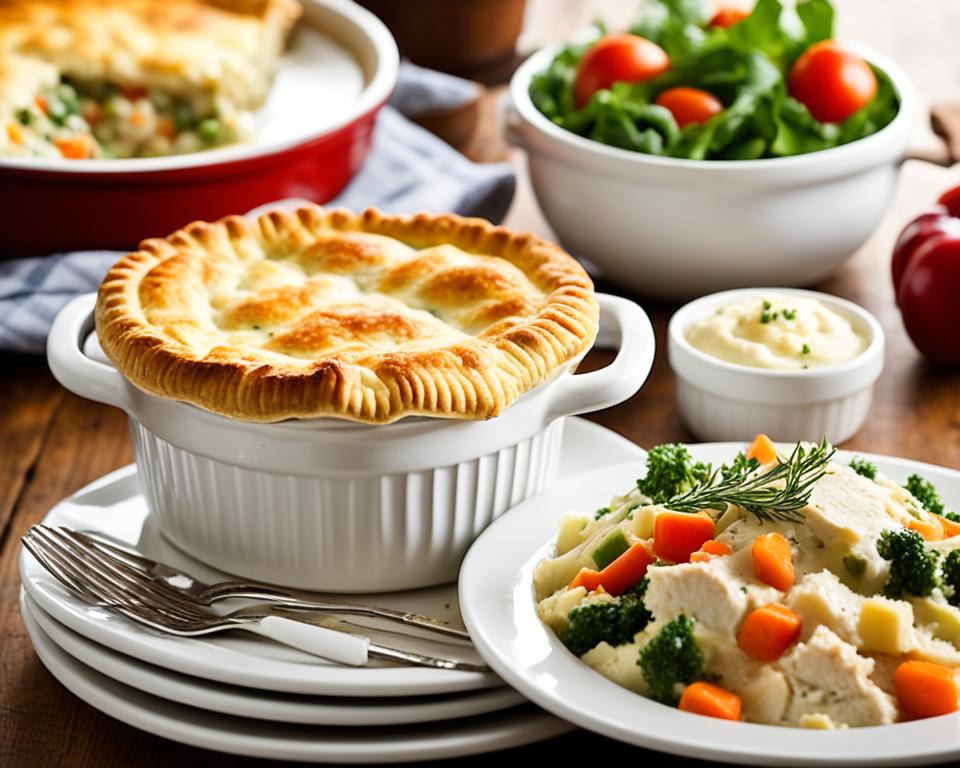
To ensure each mouthful is as pleasing as the last, a balance must be struck between the robust flavors of the pot pie and the side dishes chosen to accompany it. Here are some ideal pairings that promise to enhance your dining experience while maintaining that homemade essence we all cherish in classic comfort dishes.
- Roasted Vegetables: A medley of roasted vegetables seasoned simply with salt, pepper, and a touch of olive oil can provide a caramelized, earthy element to the meal.
- Garden Salad: Opt for a light garden salad with a tangy vinaigrette to add a crisp freshness that cuts through the richness of the pot pie.
- Garlic Mashed Potatoes: For an indulgent treat, creamy garlic mashed potatoes make a luxurious companion to the flaky pastry and tender chicken filling.
- Steamed Green Beans: These provide a crunchy, healthy addition that complements the pot pie without detracting from its flavor.
Selecting side dishes with distinct textures also help in creating a multi-dimensional eating experience. The interplay of crunch from the salad, the soft warmth from the vegetables, or the creamy smoothness of mashed potatoes sets the stage for a truly satisfying meal.
Considering seasonality can also lead to fresh, flavorful choices that will boost the home-cooked appeal of your chicken pot pie. Utilize vegetables and herbs that are in peak season for a side dish that’s as vibrant and tasty as it is nutritious.
To complete your culinary masterpiece, here is a guide for how to successfully pair your pot pie with these suggested side dishes:
| Side Dish | Texture Contrast | Flavor Profile |
|---|---|---|
| Roasted Vegetables | Crispy outside, tender inside | Earthy with natural sweetness |
| Garden Salad | Crunchy and fresh | Bright, tangy |
| Garlic Mashed Potatoes | Creamy and smooth | Rich garlic and buttery |
| Steamed Green Beans | Firm to the bite | Mild, subtly sweet |
In essence, crafting the perfect accompaniment to your homemade pot pie is all about balance and harmony. Experiment with flavors and textures to discover the combinations that resonate best with your personal tastes, making your classic comfort dish a memorable one.
Storage Tips: Keeping Chicken Pot Pie Fresh
A delectable hearty chicken pot pie is not only a joy to prepare and serve but also to savor in the days that follow. Proper storage techniques are essential to preserving the exquisite flavors and textures that define this comfort food staple. Whether one has indulged in baking a fresh pie or has satisfying leftovers to treasure, these tips ensure the pot pie remains as appealing as when it first emerged from the oven.
To maintain the signature flaky crust and moist filling of your hearty chicken pot pie, it’s important to allow the cooked pie to cool completely before proceeding to store it. Rushing this step can lead to unwanted moisture buildup within the storage container, jeopardizing the structural integrity of the crust and potentially affecting the savory filling.
For those who love to plan ahead, unbaked chicken pot pies offer a fantastic make-ahead option. These pies can be assembled and frozen, then baked straight from the freezer when the time comes—a convenience that doesn’t sacrifice the freshness or quality of this beloved dish.
- Allow the cooked chicken pot pie to reach room temperature before storing to prevent condensation.
- Refrigerate leftover pot pie within two hours of baking to ensure food safety.
- Wrap the pie securely with plastic wrap or aluminum foil, or place in an airtight container.
- For short-term storage, refrigerate your pot pie where it can be enjoyed within 3-4 days.
- For long-term storage, freeze the pot pie, either baked or unbaked, ensuring it’s well-wrapped to avoid freezer burn.
- When ready to eat, reheat refrigerated pot pie in the oven to retain the crust’s texture.
- To bake a frozen, unbaked pie, do not thaw; place directly in the oven, adjusting the baking time as necessary.
The following table provides a clear guide on how to store your chicken pot pie efficiently, keeping it perfectly delectable for future enjoyment:
| Storage Method | Temperature | Duration | Resulting Quality |
|---|---|---|---|
| Refrigeration (Cooked Pie) | Below 40°F (4°C) | 3-4 days | Preserves texture and flavor |
| Freezing (Unbaked Pie) | 0°F (-18°C) or below | Up to 3 months | Maximizes freshness upon baking |
| Freezing (Baked Pie) | 0°F (-18°C) or below | Up to 3 months | Maintains flavor, requires recrisping of crust |
| Reheating (Refrigerated Pie) | 375°F (190°C) | Until heated through | Restores flakiness of crust |
By following these guidelines, one ensures that every slice of hearty chicken pot pie remains as delightful as the first, whether enjoyed immediately or savored at a later date. Proper storage is key to extending the life and enjoyment of this quintessential comfort dish.
Flaky Chicken Pot Pie: A Step-by-Step Baking Guide
Embarking on the journey to create a heartwarming homemade pot pie recipe is a foray into the world of comforting flavors and textures. This step-by-step guide is designed to walk home cooks through the process of crafting a chicken pot pie that’s both flaky and delicious, ensuring a triumph in the kitchen every time.
Begin with the fundamentals—a flawless pie dough, resting cold in the fridge, awaiting its destiny. From there, navigate through the meticulous preparation of a chicken filling that sings with flavor. The final stage, a golden-brown bake in the oven, is what crowns the pie with its signature flaky texture. Follow these detailed steps to create a pie that is as delightful to behold as it is to devour.
- Prep the Dough: Start by rolling the chilled dough into two circles, one larger than the other, accommodating the bottom and top of your pot pie.
- Prepare the Filling: Sauté vegetables until tender, simmer with broth and potatoes, and enrich with a butter-flour and milk-cornstarch mixture for that perfect filling consistency.
- Assemble the Pie: Lay the larger dough circle in your pie dish, filling it with the cooled chicken mixture, and then cover with the second dough circle. Seal the deal with a crimped edge.
- Bake to Perfection: After brushing the top with an egg yolk wash for a glossy finish, bake your pie until the crust is golden brown and crisp.
All that stands between you and a soul-satisfying meal is the settling period post-bake—a time when the filling thickens and settles, and the flavors meld into the comforting classic we all cherish.
| Stage | Action | Tip |
|---|---|---|
| Dough Preparation | Roll chilled dough into circles and place one in the pie dish | Keep dough cold for a flakier crust |
| Filling Creation | Combine sautéed vegetables, cooked chicken, and thickened broth mixture | Let filling cool before assembling to prevent a soggy bottom |
| Pie Assembly | Add filling to dough-lined dish and cover with the top crust | Seal edges tightly to keep filling from leaking |
| Baking Process | Bake until crust is golden brown, about 50 minutes | Brush with egg yolk for a beautifully shiny, golden crust |
Each step, performed with care, contributes to the distinguished character of your homemade chicken pot pie. With this guide, even novice bakers can approach this recipe with confidence, knowing that the result will be a perfect representation of home-cooked luxury. Revel in the pleasure of flaky layers and a warm, savory filling that make this homemade pot pie recipe an enduring favorite.
The Joy of Sharing: Serving Homemade Pot Pie to Family and Friends
There’s something inherently heartwarming about serving a savory pie dish that you’ve prepared with your own two hands. The joy of sharing a homemade pot pie recipe with family and friends transcends the boundaries of mere nourishment, fostering an atmosphere of genuine camaraderie. Every slice of this comfort food, crafted with care, becomes a reason to gather, share stories, and create new memories around the dining table.
Offering a homemade pot pie at the communal table is a gesture that resonates with love and care. It’s a beloved comfort food that has the power to turn an ordinary evening into a special occasion. The richness of the filling, encased in a flaky golden crust, is shared eagerly among diners, each bite reinforcing the bonds that connect loved ones and a homemade pot pie recipe’s capability to convey affection and warmth.
Indeed, the homemade pot pie stands as a culinary emblem of home and heart. As forks delve into the tender crust revealing the savory treasures within, smiles abound, and appreciative sighs fill the room. In these moments, the true essence of comfort food becomes abundantly clear—it’s not just in its taste but in the shared experience it brings to family and friends, nurturing not just the body but also the soul.
FAQ
What makes a chicken pot pie flaky and delicious?
The ultimate flakiness of a chicken pot pie comes from using very cold butter and handling the dough as little as possible, while the deliciousness of the filling results from a combination of tender chicken, aromatic vegetables, and the perfect balance of chicken broth and cream.
Can I make a homemade chicken pot pie that’s better than store-bought?
Absolutely, a homemade chicken pot pie is superior to store-bought varieties. Homemade pies offer fresher ingredients, no preservatives, and the joy of customizing your pot pie to your own tastes.
What are the best chicken and vegetables to use in a pot pie?
For the best taste and texture, use tender, juicy chicken, ideally cooked slowly or by sous vide. Elevate your pie filling with aromatic vegetables like onions, carrots, celery, and peas to add flavor and comfort.
How can I ensure my pot pie crust is perfect?
A perfect pot pie crust can be achieved by using cold butter, avoiding overworking the dough, and incorporating a touch of vinegar to prevent gluten formation.
Is there a simple, easy way to prepare chicken pot pie?
Yes, an easy chicken pot pie starts with sautéing vegetables to release flavors, cooking the potatoes, and then thickening the filling with butter, flour, milk, and cornstarch before adding the chicken and peas.
How do you get a golden-brown crust on a pot pie?
To achieve a buttery-soft, golden-brown crust, use small cubes of very cold butter in the dough, and brush the top of your crust with an egg yolk wash before baking to achieve that perfect golden finish.
What’s the secret to a rich and creamy chicken pot pie filling?
The secret lies in finding the perfect balance between chicken broth and cream for creaminess, using both flour and cornstarch as thickening agents to get the ideal consistency that’s flavorful but not too dense.
When is it best to use flour vs. cornstarch in pot pie filling?
Flour provides a hearty taste and rich color to the pot pie filling, while cornstarch offers a clear thickening agent that doesn’t alter flavor. A combination of both gives you the perfect consistency.
How can I personalize my chicken pot pie?
Personalize your chicken pot pie by adding your favorite herbs and spices, or cater to vegetarians by substituting chicken with ingredients like mushrooms or mixed veggies.
What side dishes pair well with chicken pot pie?
Choose side dishes that complement the rich, savory flavors without overshadowing the heartiness of the pie. Think simple salads, steamed vegetables, or a light fruit compote.
How should I store chicken pot pie to keep it fresh?
Store cooked pot pies by letting them cool first, then refrigerate or freeze to maintain quality. Unbaked pies can be frozen and baked straight from the freezer for a fresh taste.
Can you provide a step-by-step guide to baking the perfect chicken pot pie?
Yes, a step-by-step guide would detail the process from rolling out the crust, to filling it with the chicken mixture, and baking until the crust is perfectly golden brown and flaky.
How does sharing homemade pot pie benefit family and social gatherings?
Sharing a homemade pot pie offers a sense of community, satisfaction, and creates memorable experiences, reinforcing its status as a beloved comfort food and bringing warmth to family gatherings.

